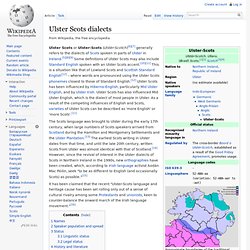

Anglo-Frisian languages. The Anglo-Frisian languages form a group of West Germanic languages consisting of Old English, Old Frisian, and their descendants.

The Anglo-Frisian family tree is: The Anglo-Frisian languages are distinguished from other West Germanic languages partially by the Ingvaeonic nasal spirant law, Anglo-Frisian brightening, and by the palatalization of Proto-Germanic *k to a coronal affricate before front vowels, e.g. English cheese, West Frisian tsiis vs. Dutch kaas, Low German Kees, German Käse; orEnglish church, West Frisian tsjerke vs. Dutch kerk, Low German Kerk, Kark, German Kirche. Anglo-Frisian developments[edit] The following is a summary of the major sound changes affecting vowels in chronological order:[3] Comparison[edit] The words for the numbers one to ten in the Anglo-Frisian languages: Ae /eː/, /jeː/ is the adjectival form used before nouns.[4] Scots language. Because there are no universally accepted criteria for distinguishing languages from dialects, scholars and other interested parties often disagree about the linguistic, historical and social status of Scots.[7] Although a number of paradigms for distinguishing between languages and dialects do exist, these often render contradictory results.

Broad Scots is at one end of a bipolar linguistic continuum, with Scottish Standard English at the other.[8] Consequently, Scots is generally regarded as one of the ancient varieties of English, yet it has its own distinct dialects.[7] Alternatively, Scots is sometimes treated as a distinct Germanic language, in the way Norwegian is closely linked to, yet distinct from, Danish.[7] Nomenclature Etymology History The growth and distribution of Scots in Scotland and Ulster: From the thirteenth century Early Scots spread further into Scotland via the burghs, proto-urban institutions which were first established by King David I.
Status Language shift. Ulster Scots dialects. The Scots language was brought to Ulster during the early 17th century, when large numbers of Scots speakers arrived from Scotland during the Hamilton and Montgomery Settlements and the Ulster Plantation.[13] The earliest Scots writing in Ulster dates from that time, and until the late 20th century, written Scots from Ulster was almost identical with that of Scotland.[14] However, since the revival of interest in the Ulster dialects of Scots in Northern Ireland in the 1990s, new orthographies have been created, which, according to Irish language activist Aodán Mac Póilin, seek "to be as different to English (and occasionally Scots) as possible.

"[15] It has been claimed that the recent "Ulster-Scots language and heritage cause has been set rolling only out of a sense of cultural rivalry among some Protestants and unionists, keen to counter-balance the onward march of the Irish language movement. Yola language. History[edit] Modern English was widely introduced by British colonists during and after the 17th century, forming the basis for the modern Hiberno-English of southern Ireland.

The new varieties were notably distinct from the surviving relict dialects.[2][3] As English continued to spread, both the Forth and Bargy dialect and the Fingal dialect died out in the 19th century. Phonology[edit] As in the Dutch language, southwestern varieties of English and (to a lesser extent) German, most voiceless fricatives in Forth and Bargy became voiced. The Middle English vowels are well-preserved, with no evidence of the Great Vowel Shift. Grammar[edit] Pronouns[edit] Forth and Bargy pronouns are similar to Modern English pronouns except in the first person singular and third person plural.[5] Articles[edit] The definite article was at first a, which was later replaced by the.
Verb[edit] Forth and Bargy verbs had some conservative characteristics. Nouns[edit] Vocabulary[edit] Interrogative words Prepositions. Fingalian language. Fingallian or the Fingal dialect is an extinct variety of English formerly spoken in Fingal, Ireland.

It is thought to have been an offshoot of Middle English, which was brought to Ireland during the Norman invasion, and was extinct by the mid-19th century. Although little is known of Fingallian, it is thought to have been similar to the Yola language of County Wexford.[1] The surviving literature of Fingallian consists of two satirical or humorous poems, the short "Fingallian Dance" and the much longer Purgatorium Hibernicum.
Both poems are anonymous and are thought to be humorous parodies of Fingallian by non-native speakers, so their value from a linguistic point of view may be limited.